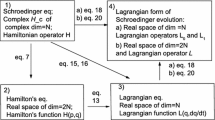Abstract
Two Lagrangians L and L′ are equivalent if the equations of motion derived from them have the same set of solutions. In that case, a matrix Λ may be defined which has the property that the trace of any analytic function of Λ is a constant of the motion. We extend this trace theorem to the case of classical field theory and discuss some of the implications for quantum theory and for procedures for finding equivalent Lagrangians.
Similar content being viewed by others
References
S. Hojman and R. Montemayor, “S-Equivalent Lagrangians for Free Particles and Canonical Quantization,”Hadronic J. 3, 1644–1657 (1980).
M. Henneaux, “Equations of Motion, Commutation Relation and Ambiguities in the Lagrangian Formalism,”Ann. Phys. (N.Y.) 140, 45–64 (1982).
M. Henneaux and L. C. Shepley, “Lagrangians for Spherically Symmetric Potentials,”J. Math. Phys. 23, 2101–2107 (1982).
F. J. Kennedy, Jr., and E. H. Kerner, “Note on the Inequivalence of Classical and Quantum Hamiltonians,”Am. J. Phys. 33, 463–466 (1965).
G. Marmo and E. J. Saletan, “q-Equivalent Particle Hamiltonians, III. The Two-Dimensional Quantum Oscillator,”Hadronic J. 1, 955–965 (1978).
A. P. Balachandran, T. R. Govindarajan, and B. Vijayalakshmi, “Particles of Half-Integral or Integral Helicity by Quantization of a Nonrelativistic Free Particle, and Related Topics,”Phys. Rev. D 18, 1950–1959 (1978).
S. Hojman and H. Harleston, “Equivalent Lagrangians: Multidimensional case,”J. Math. Phys. 22, 1414–1419 (1981).
S. Hojman and L. F. Urrutia, “On the Inverse Problem of the Calculus of Variations,”J. Math. Phys. 22, 1896–1903 (1981).
S. Hojman and L. C. Shepley, “Lagrangianos Equivalentes,”Rev. Mex. Fis. 28, 149–205 (1982).
W. Sarlet, “The Helmholtz Conditions Revisited. A New Approach to the Inverse Problem of Lagrangian Dynamics,”J. Phys. A: Math. Gen. 15, 1503–1517 (1982).
J. R. Farias and N. L. Teixeira, “Equivalent Lagrangians in Field Theory,”J. Phys. A: Math. Gen. 16, 1517–1521 (1983).
P. A. M. Dirac,Lectures on Quantum Field Theory (Belfer Graduate School of Science, Yeshiva University, New York, 1966).
S. Hojman, “Symmetries of Lagrangians and of Their Equations of Motion,”J. Phys. A: Math. Gen. 17, 2399–2412 (1984).
P. Lax, “Integrals of Nonlinear Equations of Evolution and Solitary Waves,”Commun. Pure Appl. Math. 21, 467–490 (1968).
R. Hojman, S. Hojman, and J. Sheinbaum, “Shortcut for Constructing any Lagrangian from Its Equations of Motion,”Phys. Rev. D 28, 1333–1336 (1983).
C. R. Nappi, “Some Properties of an Analog of the Chiral Model,”Phys. Rev. D 21, 418–420 (1980).
J. F. Cariñena and L. A. Ibort, “Bilagrangian Connections and the Reduction of Lax Equations,”Lett. Math. Phys. 8, 359–365 (1984).
Author information
Authors and Affiliations
Rights and permissions
About this article
Cite this article
Hojman, S., Shepley, L.C. Equivalent Lagrangians in classical field theory. Found Phys 16, 465–481 (1986). https://doi.org/10.1007/BF01882730
Received:
Issue Date:
DOI: https://doi.org/10.1007/BF01882730



